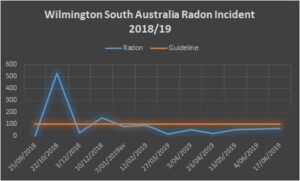Wilmington (South Australia). Radon 222
Australia’s highest radiation detection in a drinking water supply? Radon detected at over 5 times the drinking water guideline.

22/10/18: Wilmington (South Australia) – Radon 222 526Bq/L
10/12/18: Wilmington (South Australia) – Radon 222 154Bq/L
(average level October 2018-June 2019 at Wilmington 128.967Bq/L)
“Based on a consideration of the potential health impact from radon released from tap water
to the air inside a dwelling, the activity concentration of radon‑222 in drinking water should
not exceed 100 Bq/L.The guideline value applies to the concentration of radon at the point of use of the water, not at the source, because of the significant decrease in concentration which can occur due to radioactive decay during storage, treatment and reticulation.
Radon‑222 is a radioactive gas produced from the decay of radium‑226 in soil and minerals. It has a half-life of 3.8 days.
Elevated concentrations of radon‑222 may occur in drinking water derived from groundwater, due to the release of radon from aquifer rocks and minerals, particularly in granitic areas. In Finland, for example, the weighted average radon concentration in drinking water is 25 Bq/L.
Radon concentrations in surface water supplies are very low because the gas is rapidly lost to the atmosphere.
Studies from Canada, Finland and the United States have shown that dissolved radon‑222 in drinking water may be released to air during domestic use and contribute to indoor radon concentrations.
HEALTH CONSIDERATIONS
The main health risk from radon arises from inhalation of the gas, particularly when it accumulates inside dwellings. Radon‑222 has several short-lived radioactive progeny that can give rise to an increased risk of lung cancer.
Epidemiological studies of underground miners in the uranium mining industry overseas have established a relationship between the incidence of lung cancer and occupational exposure to radon.
No link has been demonstrated, however, in either experimental or epidemiological studies, between ingestion of radon in drinking water and increased cancer rates.” ADWG 2011